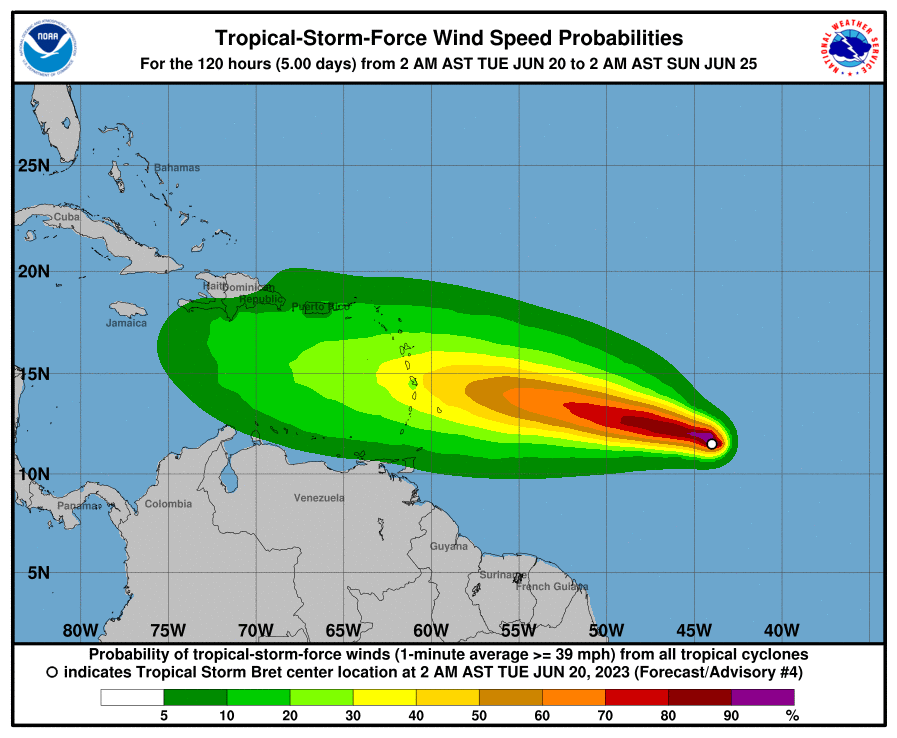
On Monday, the formation of Tropical Storm Bret marked the arrival of the second named storm in the 2023 Atlantic hurricane season.
Emerging approximately 1,300 miles to the east of the southern Windward Islands, Bret began its westward movement at a speed of 18 miles per hour, heading towards the Caribbean Sea.
According to the National Hurricane Center, the storm is expected to intensify into a hurricane while passing over the Lesser Antilles on Thursday and Friday. Although it is currently too early to pinpoint the exact location and magnitude of potential hazards, the National Hurricane Center advised residents of the Lesser Antilles, Puerto Rico, and the Virgin Islands to stay vigilant and have a well-prepared hurricane plan in place. As of late Monday, no coastal watches or warnings were in effect, but continuous monitoring of updates is crucial.
The storm's maximum sustained winds were estimated to be 40 miles per hour. When tropical storms maintain winds of at least 39 mph, they are assigned a name. Once winds reach 74 mph, the storm is upgraded to hurricane status, and if winds reach 111 mph, it becomes classified as a major hurricane.
Interestingly, Bret is actually the third tropical cyclone to achieve tropical storm strength this year. In May, the National Hurricane Center reevaluated a storm that formed off the northeastern United States in mid-January and determined it to be a subtropical storm, making it the first cyclone in the Atlantic for the year. However, this storm was not retrospectively given a name, resulting in Arlene, which formed in the Gulf of Mexico on June 2, being officially recognized as the first named storm in the Atlantic basin this year.
Living in South Florida means being well-acquainted with the annual hurricane season. While these natural disasters can be unpredictable, taking proactive measures to prepare your commercial building can help minimize potential damage and ensure the safety of occupants. We will outline a comprehensive list of actions you can take to prepare your commercial property for a potential hurricane. We will also provide information about available resources and nearby shelters in South Florida.
Develop a Hurricane Preparedness Plan: Create a detailed plan that outlines the steps to be taken before, during, and after a hurricane. Assign responsibilities to employees and establish communication channels to keep everyone informed. Review the plan regularly and conduct drills to ensure everyone is familiar with their roles and responsibilities.
Secure the Building: Protect your property from strong winds by securing windows, doors, and other vulnerable areas. Consider installing impact-resistant windows or shutters. Reinforce entryways and garage doors to prevent wind and water infiltration. Trim trees and remove loose branches that could potentially become projectiles during a storm.
Inspect and Maintain Roofing: Ensure that your commercial building's roof is in good condition. Conduct regular inspections to identify and repair any damaged or loose shingles, tiles, or other roofing materials. Reinforce roof-to-wall connections to improve structural integrity.
Clear Drainage Systems: Clean and maintain gutters, downspouts, and drainage systems to prevent blockages that can lead to flooding. Ensure that water can flow freely away from the building. Consider installing flood barriers or sandbags if necessary.
Backup Power and Utilities: Invest in a reliable backup power generator to ensure continuity of essential systems such as lights, security systems, and emergency equipment. Regularly test and maintain the generator to guarantee its functionality. Prepare for potential utility outages by having extra fuel, batteries, and necessary supplies on hand.
Secure Important Documents and Data: Back up essential documents and data electronically and store them off-site or in the cloud. Maintain physical copies of important documents in a waterproof container or a safe location. Consider creating a digital inventory of assets and equipment for insurance purposes.
Review Insurance Coverage: Evaluate your commercial property insurance coverage to ensure it adequately protects against potential hurricane-related damage. Review policy details, deductibles, and exclusions. Consult with an insurance professional to address any gaps in coverage.
Communicate and Coordinate with Tenants and Contractors: Maintain open lines of communication with tenants, contractors, and suppliers before and after a hurricane. Keep them informed about the building's preparedness plans and any necessary evacuation or safety protocols. Establish a contact list with essential emergency phone numbers.
Emergency Supplies: Stock up on emergency supplies, including non-perishable food, water, flashlights, batteries, first aid kits, and basic tools. Ensure there are enough supplies to sustain occupants for at least 72 hours. Create an emergency supply kit for each floor or department within your building.
Familiarize Yourself with Local Resources: Research and keep a list of nearby resources and shelters available in the Tri-county area. Stay informed about emergency evacuation routes and instructions from local authorities. Monitor weather updates from reliable sources such as the National Hurricane Center and local news channels.
Evacuation Shelters by County
Broward County | Dade County| Palm Beach County | Monroe County | Collier County | Lee County | Charlotte County | Sarasota County | Manatee County | Pinellas County
Hillsborough County | Martin County | St. Lucie County | Indian River County
Hurricane Resources | Pet-Friendly Shelters
Preparing your commercial building in South Florida for a potential hurricane requires careful planning, proactive measures, and a focus on safety. By following the steps outlined above, you can mitigate potential damage and protect the well-being of occupants. Remember to stay informed, maintain open communication, and prioritize the safety of everyone involved. With proper preparation, you can weather the storm and ensure a faster recovery in the aftermath of a hurricane.
